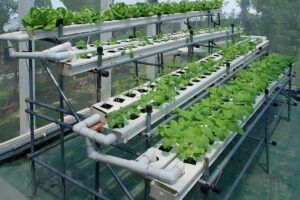Welcome to the world of home hydroponics, where gardening knows no boundaries! Growing your own plants indoors is not only a thrilling venture but an eco-friendly way to embrace nature’s miracles right at the comfort of your home. However, like any gardening method, hydroponics comes with its own set of challenges. Whether you are a novice enthusiast or a seasoned green thumb, encountering common issues along the way is inevitable. Fret not, for in this article, we will uncover the secrets to solving these obstacles, ensuring that your hydroponic garden flourishes with utmost vitality. So put on your gardening gloves, sharpen your pruning shears, and let’s dive into the magical world of home hydroponics!
Troubleshooting Hydroponic Nutrient Imbalances: Identifying and Correcting Deficiencies and Excesses
Solving Common Issues in Home Hydroponics: Tips and Troubleshooting
Is your hydroponic garden not thriving as expected? Don’t worry, nutrient imbalances can be easily identified and corrected with a little troubleshooting. By understanding the signs of deficiencies and excesses, you can ensure that your plants receive the right balance of nutrients for optimal growth and yield.
A common issue in home hydroponics is nutrient deficiency. If your plants are exhibiting stunted growth, yellowing leaves, or unusual spotting, it’s likely they lack essential nutrients. To identify specific deficiencies, closely observe the symptoms. For instance, yellowing leaves may indicate a lack of nitrogen, while browning leaf tips might signal a potassium deficiency. Once identified, corrective measures can be taken, such as adjusting the nutrient solution or adding appropriate supplements.
On the other hand, excessive nutrient levels can also hinder your plants’ development. If you notice burnt or wilting leaf edges, it’s a sign of nutrient overload. In this case, it’s crucial to dilute the nutrient solution or flush the system to rectify the imbalance. Monitoring and maintaining the electrical conductivity (EC) levels of your solution is essential to avoid excess buildup and subsequent damage to your plants’ roots. Remember, a balanced hydroponic nutrient solution is the key to a thriving and healthy garden.
Preventing and Resolving Root Rot in Home Hydroponic Systems: Essential Techniques and Best Practices
One of the most common challenges faced by home hydroponic growers is the occurrence of root rot. This fungal infection can quickly devastate your plants if not addressed promptly. Fortunately, there are several essential techniques and best practices that can help you prevent and resolve root rot in your home hydroponic system.
First and foremost, maintaining proper oxygenation is crucial in preventing root rot. Adequate oxygen levels in the nutrient solution will promote healthy root growth and make it inhospitable for the root rot fungus to thrive. To achieve this, consider incorporating an air stone or diffuser in your hydroponic system. This will ensure a consistent supply of oxygen to the roots and prevent the formation of stagnant areas where root rot can take hold.
Furthermore, regularly monitoring and maintaining the temperature of your hydroponic system is essential. Warm water promotes the growth of root rot fungi, so it is important to keep the water temperature below 70°F (21°C). You can achieve this by using a water chiller or by simply maintaining the hydroponic system in a cool location away from direct sunlight or heat sources.
In addition, practicing good hygiene is paramount in preventing and resolving root rot. Make sure to disinfect all equipment, including grow trays, nutrient reservoirs, and tools, before each use. This will help eliminate any potential sources of contamination and minimize the risk of introducing pathogens into your hydroponic system. Regularly cleaning and maintaining your system will go a long way in preventing root rot and other common issues in home hydroponics.
In conclusion, preventing and resolving root rot in home hydroponic systems requires a combination of proper oxygenation, temperature control, and good hygiene practices. By implementing these essential techniques and best practices, you can ensure the health and vitality of your plants. Remember to monitor your system regularly and address any signs of root rot promptly to keep your hydroponic garden thriving.
Addressing Algae Growth in Home Hydroponics: Effective Methods and Preventive Measures
Solving Common Issues in Home Hydroponics: Tips and Troubleshooting
Algae growth can be a common challenge in home hydroponics systems, particularly in setups where water is continually recirculated. Algae not only detracts from the visual appeal of your hydroponic garden but can also compete with your plants for essential nutrients. However, with some effective methods and preventive measures, you can maintain a clean and algae-free hydroponic system. Here are some tips to tackle this common issue:
1. Light Management
Algae thrive in the presence of light, so controlling the amount of light reaching the nutrient solution is essential. Some strategies include:
- Using opaque or light-blocking materials to cover exposed areas of the hydroponic system.
- Keeping the reservoir covered to limit light penetration.
- Adjusting the position of grow lights to minimize direct exposure to the nutrient solution.
2. Proper Water Oxygenation
Algae growth can be suppressed by ensuring optimal oxygen levels in your hydroponic system. Consider the following:
- Using an air stone or oxygen diffuser to increase oxygenation in the nutrient solution.
- Implementing a timed aeration schedule to prevent stagnant water conditions that promote algae growth.
- Regularly checking and cleaning the air stones or diffusers to maintain their effectiveness.
3. Regular Cleaning and Maintenance
Maintaining a strict cleaning schedule is vital to prevent algae from taking hold in your hydroponic setup. Here are some steps to follow:
- Remove any visible algae manually, taking care not to disrupt plant roots.
- Regularly scrub and sanitize all hydroponic system components, including reservoirs, pumps, and tubing.
- Consider using an algae-inhibiting treatment or a hydrogen peroxide solution to control algae growth.
By implementing these effective methods and adopting preventive measures, you can successfully address algae growth in your home hydroponics system. Keeping your system clean and optimizing light exposure and water oxygenation will not only enhance the overall appearance of your garden but also ensure the health and productivity of your hydroponically grown plants.
Optimizing pH Levels in Hydroponic Systems: Balancing Acidity for Healthy Plant Growth
When it comes to hydroponic systems, maintaining optimal pH levels is crucial for ensuring healthy plant growth. pH, or potential of hydrogen, measures the acidity or alkalinity of a solution. In a hydroponic setup, the pH of the nutrient solution directly affects the availability of essential nutrients to plants. If the pH is too high or too low, plants may struggle to absorb nutrients, leading to stunted growth or nutrient deficiencies. Balancing acidity in hydroponics requires careful monitoring and adjustments. Here are some tips and troubleshooting techniques to optimize pH levels in home hydroponic systems:
1. Regular pH Monitoring: Invest in a good-quality pH meter and test the nutrient solution on a regular basis. Aim for a pH range of 5.5 to 6.5 for most hydroponic crops. Keep a record of pH measurements to identify any patterns or trends.
2. pH Adjustment Techniques: If the pH is too high (alkaline), adding small amounts of pH Down (usually phosphoric acid) can help lower the pH. For low pH (acidic) levels, pH Up (typically potassium hydroxide) can be used to raise the pH. Remember, it’s best to make gradual adjustments and retest rather than making drastic changes all at once.
3. Nutrient Solution Formulation: Check the pH of your water source before mixing it with nutrients. Some water sources may have a high or low pH, which can affect the overall pH of the nutrient solution. Make adjustments to the water pH before adding nutrients and maintain a balanced nutrient solution to prevent pH fluctuations.
As we conclude our journey of unraveling the mysteries of home hydroponics, we hope that you have gained a deeper understanding and newfound confidence in this fascinating method of cultivation. By arming yourself with valuable tips and troubleshooting techniques, you can now confidently navigate your way through any challenges that arise in your hydroponic garden.
Remember, a nurturing hydroponic environment requires time, patience, and a touch of experimentation. Don’t be disheartened by setbacks, as they simply present opportunities for growth and learning. With a little TLC and a dash of problem-solving prowess, you can transform your home hydroponics setup into a flourishing haven of greenery.
Assemble your toolkit of knowledge, which now includes practical tips on nutrient imbalances, temperature fluctuations, pest invasions, and other common obstacles that hydroponic gardeners encounter. Harness this knowledge to fine-tune your system, tailoring it to your specific plants and environment, and watch them thrive like never before.
Additionally, remember that seeking assistance from fellow hydroponics enthusiasts, online communities, and local gardening stores can be invaluable. Connecting with others who share your passion and can offer advice can elevate your hydroponic experience to new heights.
So, whether you’re a seasoned hydroponics expert or just dipping your toes into this exciting world, don’t be deterred by challenges that arise. Embrace them as opportunities to explore, learn, and innovate. With determination and a touch of creativity, your home hydroponics system will not only be a source of endless fresh produce but also a canvas for your green-thumb aspirations.
So go forth, fellow hydroponic adventurers, and may your harvests be bountiful, your troubles effortlessly resolved, and your enthusiasm remain unwavering. Remember, the world of home hydroponics is an ever-evolving one, awaiting your brilliance and ingenuity to carve out even more innovative solutions for a greener tomorrow. Happy growing!



